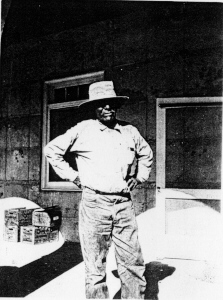Trona on the Web: Indian George
 Indian George 1918- J. Whitelaw Collection Indian George Hanson (also know as Indian George Inyo) is the best of the Indians alive at the time of the Silver Stampede into Panamint City, the golden years of Ballarat, and the early mining of borax by John Searles. That name was given to him by the white men when he was employed as a wood-packer at Panamint City in the early 1870s. His Indian name was Bah-vanda-savany-kee (meaning boy who ran away). Indian George remembered the immigrants who were part of the Jayhawker, Manly-Bennett Party in the winter of 1849-1850. These stalwarts came across Death Valley and the Panamints. George's name is connected to these immigrants. He was called "Boy who ran away," because when he saw the white men he was afraid and ran away. He was a small by at the time and had never before seen a white man, much less "cows" the oxen drawing wagons, nor the wagons themselves. George was born at Surveyor Wells in Death Valley about 1841. He died at around the age of 105 and is buried somewhere in the Mesquites. No white man knows where the Indians hide their graves. He is thought to be buried near the Indian Ranch in Panamint Valley, ten miles north of Ballarat, where he lived the winters for over 80 years. In 1930, his family consisted of his sister, "Old Woman"; a daughter, Isobel; a granddaughter, and Molly who herded the Angora goats which had been provided by the Indian service. Molly and the goats wintered at the Indian Ranch which had a crude water system built to supply water from Hall Canyon. It was a system of flumes which brought the water to the ranch for irrigation and domestic use. This water system was intact until very recently when vandals destroyed it along with many other historic relics of the Indians life at the ranch. Warm Springs, near the Indian Ranch, was used for grazing the goats. In the late spring. Molly took the goats up to the Panamints where grazing was better and water was abundant. For many years before Molly, the Indians had camped in Pleasant Canyon near the Stone Corral in the summer. After most of the Indians had died or left the area, many returned to the old summer camping ground and poked around obviously looking for something. Miners in the area were never able to find what the Indians were seeking. The food of the Indians in the Panamints like in the other mountains of the Mojave Desert was pinion nuts, wild animals and a umber of edible plants. Squaw tea plants are numerous in the higher elevations of the Panamints from which a hot drink was brewed. George Pipkin was privileged to learn first hand from some of the Indians about their families, customs, and legends. George and his wife, Ann, were resident manager and co-owner of Wildross Station at the entrance of Death Valley Monument through Wild Ross Canyon from 1946 until 1950. Here much of the material for the book was gathered. Sometimes Mike, the crippled son of Indian George, would come on his crutches along with his three sons, Leland, Dugan and Buster, to live at the ranch. They lived at Darwin most of the time. George and his family, like many Indians of the eastern Sierra, are classed as Shoshone. However, locally they were known as the Panamint Indians. Indian Ranch, still and Indian reservation, is leased from time to time for grazing purposes upon bid. Indian George and his people got their salt from Searles Lake. That was how he met John Searles. He and his father worked for Searles, alongside the Chinese brought into the Mojave Desert for road building and other labor tasks. When telling about Ballarat, which Indian George called "Kow-wah," he said, "Many men come. Houses spring up over night. Freight teams and stages coming-going all the time. Many saloons, much firewater. Lots shooting and fights. No place for Indian. Good place to stay away from." The above information was copied from the Searles Valley Historical Society "OL' TIMER" Volume IX No. 3 July, August, September 1994 newsletter, where this excerpt was reprinted from the book Ballarat - Facts & Folklore (1897-1917) written by Paul Hubard, Doris Bray and George Pipkin. |